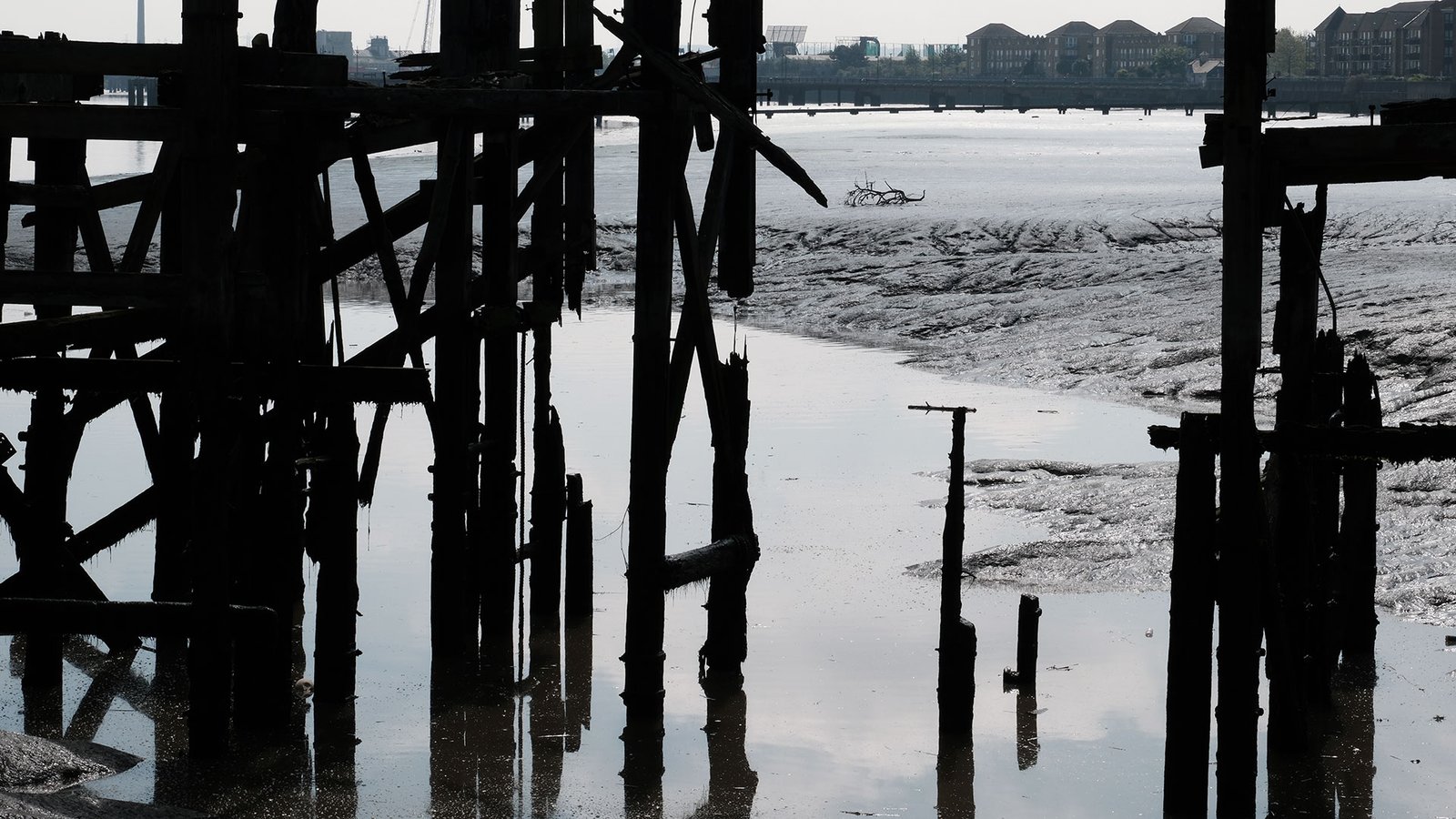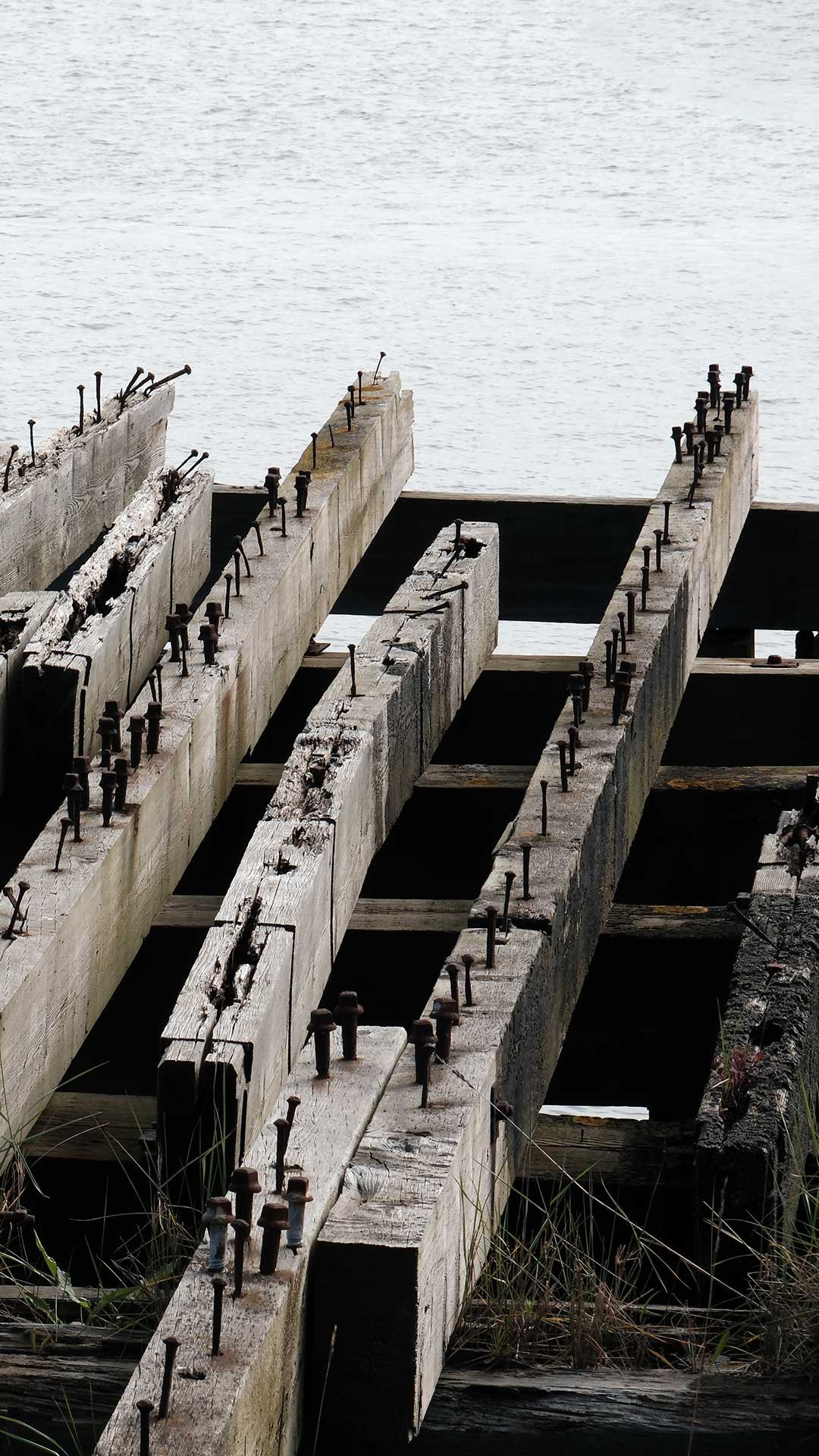
& asphalt

Asphalt is a sticky, black, highly viscous liquid or semi-solid form of petroleum. It is commonly used as a binder in road construction and waterproofing materials.
Asphalt is primarily made from a mixture of bitumen (a black, sticky substance derived from crude oil) and aggregates such as sand, gravel, or crushed stone. Additional additives like polymers and fillers may also be included to enhance its properties for specific applications.

the Thames a reflective ribbon, the asphalt tower, piers reach out with splintered fingers.


● estuary & asphalt
In the heart of Erith…
…where the Thames expands into a broad, reflective ribbon of water, the Conway Asphalt building standing sentinel among the ruins of industrial ambition. The air here is thick with bitumen mingling with the damp breath of the river. This is a landscape of derelict piers and anonymous industrial buildings, where the remnants of human enterprise decay in a slow repetitive banging.
The piers, skeletal and spectral, extend into the water like the outstretched fingers of forgotten bodies. Their rusted iron and splintered wood tell tales of departed sea-crafts, of cargoes once vital to the arteries of commerce now dissolved into the ether. Walking among these piers, the creak of ropes, and the rhythmic clang of iron against iron. These sounds, though diminished, linger in the air, a ghostly refrain of industry that has slipped into obsolescence.
In Erith, the interplay between the natural and the man-made creates a tapestry of desolation and beauty. The derelict piers jutting into the Thames seem to yearn for the past, their decay a slow surrender to the river’s inexorable flow. The Conway Asphalt building, with its utilitarian purpose now precarious, stands as a mausoleum of industrial might, its walls absorbing the silence of inactivity. Walking through this landscape, one is struck by the juxtaposition of stillness and the remnants of movement. The air is thick with stasis, yet beneath it, there is a subtle vibration, a reminder of the energy that churns in these spaces. The anonymous industrial structures, devoid of human presence, are boxes for the imagination, their forms only suggest their purpose, at lives lived in the shadows of progress. Among this remnant of industry, one can sense the faint echoes of ambition and the slow, inevitable reclamation by nature. It is a landscape where the ghosts of progress linger, where the materials of construction and the passage of time converge in a elegiac symphony.
● estuary & asphalt: 5m46s
In the heart of Erith…
…where the Thames expands into a broad, reflective ribbon of water, the Conway Asphalt building standing sentinel among the ruins of industrial ambition. The air here is thick with bitumen mingling with the damp breath of the river. This is a landscape of derelict piers and anonymous industrial buildings, where the remnants of human enterprise decay in a slow repetitive banging.
The piers, skeletal and spectral, extend into the water like the outstretched fingers of forgotten bodies. Their rusted iron and splintered wood tell tales of departed sea-crafts, of cargoes once vital to the arteries of commerce now dissolved into the ether. Walking among these piers, the creak of ropes, and the rhythmic clang of iron against iron. These sounds, though diminished, linger in the air, a ghostly refrain of industry that has slipped into obsolescence.
In Erith, the interplay between the natural and the man-made creates a tapestry of desolation and beauty. The derelict piers jutting into the Thames seem to yearn for the past, their decay a slow surrender to the river’s inexorable flow. The Conway Asphalt building, with its utilitarian purpose now precarious, stands as a mausoleum of industrial might, its walls absorbing the silence of inactivity. Walking through this landscape, one is struck by the juxtaposition of stillness and the remnants of movement. The air is thick with stasis, yet beneath it, there is a subtle vibration, a reminder of the energy that churns in these spaces. The anonymous industrial structures, devoid of human presence, are boxes for the imagination, their forms only suggest their purpose, at lives lived in the shadows of progress. Among this remnant of industry, one can sense the faint echoes of ambition and the slow, inevitable reclamation by nature. It is a landscape where the ghosts of progress linger, where the materials of construction and the passage of time converge in a elegiac symphony.

Anonymous industrial structures populate the landscape, their utilitarian forms stripped of ornamentation, standing in stark contrast to the organic curves of the river and the soft, undulating greenery that surrounds them. These buildings exude both forlorn dignity and the sheeted resistance of server farms. Their windows — if present — are opaque with grime, and half-reflect a fractured vision of a world that has moved on, leaving these structures as silent witnesses to the passage of time and shipping.
Asphalt, the material that underpinned the very foundations of progress, here takes on a symbolic weight. The Conway Asphalt building, with its weathered façade and near-silent machinery, stands as a monument to a world where roads stretched into the horizon, promising connection and commerce. The scent of asphalt, heavy and pungent, still clings to the building’s walls, a reminder of the countless roads paved, the relentless advance of modernity. It is as if the very essence of movement has been fossilised within these walls, now motionless, capturing a moment in the relentless march of time.
Anonymous industrial structures populate the landscape, their utilitarian forms stripped of ornamentation, standing in stark contrast to the organic curves of the river and the soft, undulating greenery that surrounds them. These buildings exude both forlorn dignity and the sheeted resistance of server farms. Their windows — if present — are opaque with grime, and half-reflect a fractured vision of a world that has moved on, leaving these structures as silent witnesses to the passage of time and shipping.
Asphalt, the material that underpinned the very foundations of progress, here takes on a symbolic weight. The Conway Asphalt building, with its weathered façade and near-silent machinery, stands as a monument to a world where roads stretched into the horizon, promising connection and commerce. The scent of asphalt, heavy and pungent, still clings to the building’s walls, a reminder of the countless roads paved, the relentless advance of modernity. It is as if the very essence of movement has been fossilised within these walls, now motionless, capturing a moment in the relentless march of time.

FM Conway
Erith Asphalt Plant & Erith Wharf

